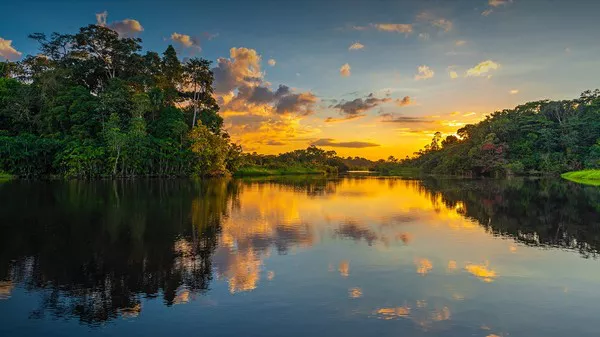Wetlands are crucial ecosystems that support a diverse range of wildlife and play a significant role in environmental health. They are defined by their water-saturated conditions and include areas like marshes, swamps, and bogs. This article provides a detailed overview of the ten largest wetlands globally, highlighting their size, ecological significance, and unique characteristics.
Top 10 Largest Wetlands in the World
1. Amazon Basin, South America
Overview
The Amazon Basin, primarily spanning Brazil, Peru, Colombia, and several other South American countries, is the largest and most extensive wetland in the world. Covering approximately 7 million square kilometers (2.7 million square miles), it is a vital component of the Earth’s climate system and biodiversity.
Ecological Significance
- Biodiversity Hotspot: Home to thousands of plant and animal species, many of which are endemic.
- Carbon Sink: Plays a critical role in regulating global carbon levels by storing vast amounts of carbon in its vegetation and soil.
- Water Cycle: Influences regional and global water cycles, affecting weather patterns and rainfall.
Unique Features
- Flooded Forests: The varzea and igapo forests are seasonal floodplains that support unique flora and fauna.
- Rich Aquatic Life: Includes species like the Amazon river dolphin and the giant river otter.
See Also: 10 Most Dangerous Oceans and Seas
2. Pantanal, South America
Overview
The Pantanal, straddling Brazil, Bolivia, and Paraguay, is the world’s largest tropical wetland, covering approximately 150,000 square kilometers (58,000 square miles). It is renowned for its high biodiversity and seasonal flood patterns.
Ecological Significance
- Biodiversity: Hosts a rich array of wildlife including jaguars, capybaras, and hundreds of bird species.
- Seasonal Flooding: The region experiences annual floods that create diverse habitats and support numerous species.
Unique Features
- Wetland Ecosystem: Composed of wetlands, floodplains, and savannas.
- Birdwatching Destination: Known for its birdwatching opportunities with species like the hyacinth macaw.
3. Okavango Delta, Africa
Overview
Located in Botswana, the Okavango Delta is a unique inland delta covering approximately 15,000 square kilometers (5,800 square miles). It is renowned for its complex network of waterways and seasonal flooding.
Ecological Significance
- Biodiversity: Supports a diverse range of wildlife including elephants, lions, and various aquatic species.
- Habitat Diversity: The delta’s seasonal flood pulses create a mosaic of habitats, supporting different species throughout the year.
Unique Features
- Flood Pulse System: The delta’s annual flooding is caused by rains in the Angolan highlands, creating a temporary wetland.
- Cultural Importance: Home to the indigenous San people who have adapted their lifestyles to the delta’s seasonal changes.
4. Sudd Wetlands, Africa
Overview
The Sudd Wetlands, located in South Sudan, cover approximately 30,000 square kilometers (11,600 square miles). It is one of the largest freshwater wetlands in the world, created by the White Nile River.
Ecological Significance
- Biodiversity: Supports a variety of bird species, fish, and mammals.
- Floodplain Dynamics: The Sudd’s water levels fluctuate significantly, creating diverse habitats.
Unique Features
- Vegetation: Characterized by extensive reed beds and floating vegetation.
- Fishery: Important for local communities who rely on fishing for sustenance.
5. Great Salt Lake Wetlands, North America
Overview
The Great Salt Lake Wetlands in Utah, USA, cover an area of approximately 4,000 square kilometers (1,500 square miles). This saline wetland is the largest of its kind in North America.
Ecological Significance
- Bird Migration: Serves as a critical stopover for migratory birds along the Pacific Flyway.
- Unique Ecosystem: Supports specialized flora and fauna adapted to saline conditions.
Unique Features
- Salt Flats: The lake’s salinity creates unique landscapes and habitats.
- Brine Shrimp: The lake supports large populations of brine shrimp, which are an important food source for birds.
6. Mississippi Alluvial Valley Wetlands, North America
Overview
The Mississippi Alluvial Valley Wetlands extend along the Mississippi River in the United States, covering approximately 26,000 square kilometers (10,000 square miles). They are known for their rich soil and seasonal flooding.
Ecological Significance
- Floodplain Ecosystem: Provides important flood control and nutrient cycling for the surrounding regions.
- Wildlife Habitat: Supports diverse wildlife including waterfowl and fish.
Unique Features
- Wetland Restoration: Ongoing efforts to restore and conserve these wetlands to support biodiversity and mitigate flooding.
- Agricultural Impact: The fertile soils have been extensively converted to agricultural use, impacting the wetland ecosystem.
7. Mekong Delta, Asia
Overview
The Mekong Delta, located in Vietnam, covers approximately 40,000 square kilometers (15,400 square miles). It is a vital wetland region formed by the
Mekong River and its tributaries.
Ecological Significance
- Biodiversity: Rich in aquatic species, including fish and reptiles.
- Economic Importance: Supports agriculture and fisheries, crucial for local economies.
Unique Features
- Delta Dynamics: Characterized by a complex network of rivers, channels, and floodplains.
- Cultural Significance: Home to diverse ethnic communities with traditional practices adapted to the delta’s conditions.
8. Kafue Flats, Africa
Overview
The Kafue Flats, located in Zambia, cover an area of approximately 8,000 square kilometers (3,100 square miles). They are an important wetland area created by the Kafue River.
Ecological Significance
- Biodiversity: Supports a range of wildlife, including antelopes and birds.
- Flood Regime: The annual floods create temporary wetlands that support diverse species.
Unique Features
- Wetland Management: Key area for conservation and management to protect wildlife and sustain local communities.
- Fishing: Important for local fisheries and subsistence.
9. Yoo Long Swamp, Asia
Overview
The Yoo Long Swamp, located in China, covers approximately 7,500 square kilometers (2,900 square miles). It is a significant wetland area in the Yunnan Province, formed by river systems and seasonal flooding.
Ecological Significance
- Wetland Ecosystem: Supports various plant and animal species adapted to seasonal changes.
- Water Regulation: Plays a role in regulating water flow and maintaining water quality in the region.
Unique Features
- Seasonal Variability: The swamp’s condition varies with the seasons, influencing the types of habitats available.
- Cultural Value: Important for local cultures and traditional practices.
10. Danube Delta, Europe
Overview
The Danube Delta, spanning Romania and Ukraine, covers approximately 5,800 square kilometers (2,200 square miles). It is one of Europe’s largest and most biodiverse wetland areas.
Ecological Significance
- Biodiversity: Home to a wide range of bird species, fish, and plant life.
- Floodplain Dynamics: The delta’s complex hydrology supports various habitats and ecological processes.
Unique Features
- Protected Area: Designated as a UNESCO World Heritage Site for its ecological significance.
- Tourism: Popular destination for birdwatching and ecotourism.
SEE ALSO: The Most Acidic Lakes in the World: Kawah Ijen Crater Lake
Conclusion
Wetlands are invaluable ecosystems that provide critical services to the environment and human communities. The ten largest wetlands discussed here—ranging from the Amazon Basin to the Danube Delta—highlight the immense scale and ecological importance of these areas. They support diverse wildlife, influence global climate patterns, and offer essential resources and services to people around the world. Protecting and preserving these wetlands is crucial for maintaining biodiversity and ensuring the health of our planet’s natural systems.
You Might Be Interested In:

























